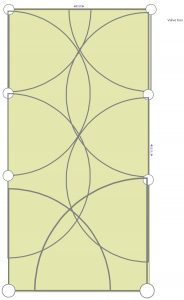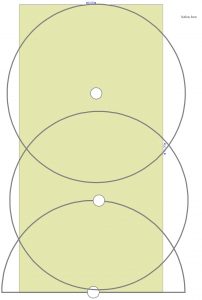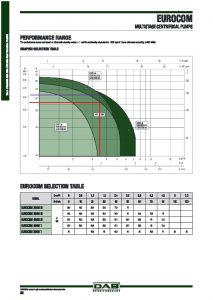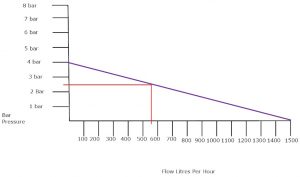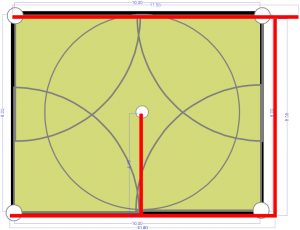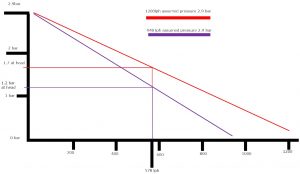What happens when water is pushed through up water pipe
The correct pipe diameter is decided based on the amount the volume of water being used or the flow through the pipe. When water is pushed along a pipe friction is created. The amount of friction depends on the speed the water the water needs to move along the pipe in order to supply the volume of water at the outlet. This loss in flow is called friction loss. There are other factors that will contribute to flow and pressure loss, as an example elbows etc however for this example we will assume a straight run with no connectors
How large is the variation
In the example below we will assume that we are going t be using 2500 litres per hour at the outlet and that the total length of the pipe is 100 metres. We will assume that our pump is delivering 4500 litres per hour in to the pipe at 5 bar pressure

In figure 1 we are supplying 4500 litres per hour at 5 bar pressure and we have opened the tap to allow 2500 litres per hour to exit. In order for the 2500 litres per hour to exit the pipe the water will move with a velocity of 1.9 metres per second. Velocities at over 1.5 metres per second should always be avoided as this can cause water hammer. Over the 100 metre length we will see a loss of 2.16 bar pressure due to the internal friction of the pipe. So the pressure at the exit would = 5 – 2.16 = 2.84 bar.
In Figure 2 we are supplying exactly the same amount of water at the same pressure however the external pipe diameter is now 32 mm and the pipe wall thickness is exactly the same. In order to supply the 2500 litres per hour at the outlet the water will need to travel at 1.1 metres per second. The friction loss in the 32 mm pipe is 0.54 bar over the 100 metre length so our outlet pressure will be 5 – 0.54 = 4.46 bar. From this we can see that with a slight change in pipe diameter we have a huge energy saving.
If we were to increase the diameter of the pipe to 50 mm we would see a 0.19 bar pressure drop based on the above figures making this the most efficient option however cost wise it would not be the prefered choice, the 32 mm dimeter pipe would be the prefered option.
What size water pipe should I use
You now having an understanding of what happens when you run water through a water pipe. From this information you can now decide on the diameter required however there are numerous other variable that will change your calculations, for example elbows, turns, type of pipe and wall thickness of the pipe. Our advice is to email us at [email protected] or call us on 01189736905 so that we can calculate your requirements preventing expensive and time consuming mistakes


